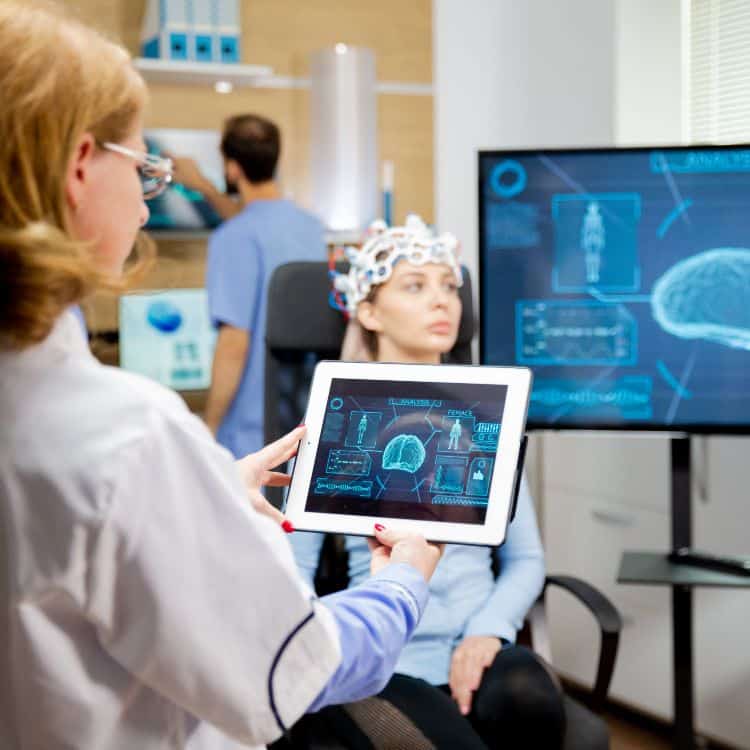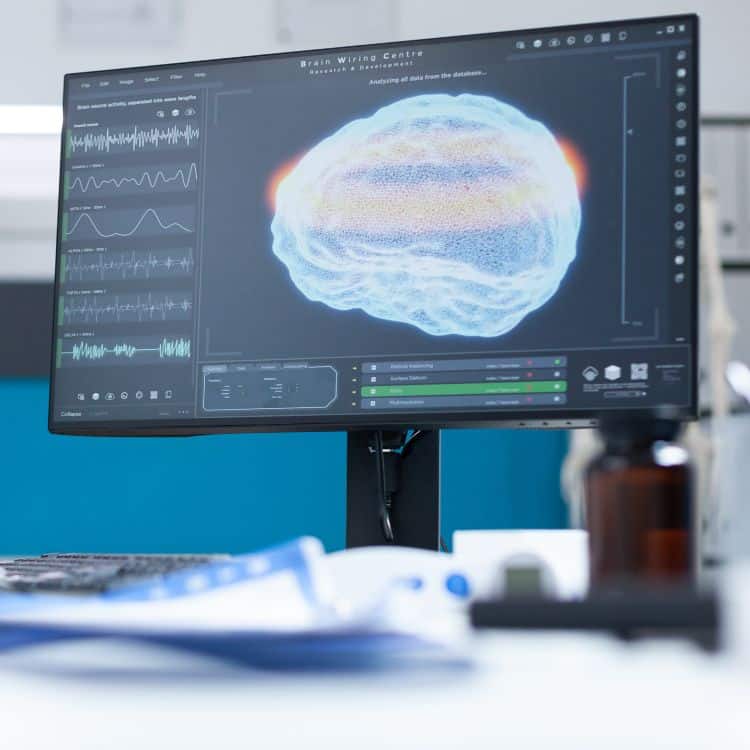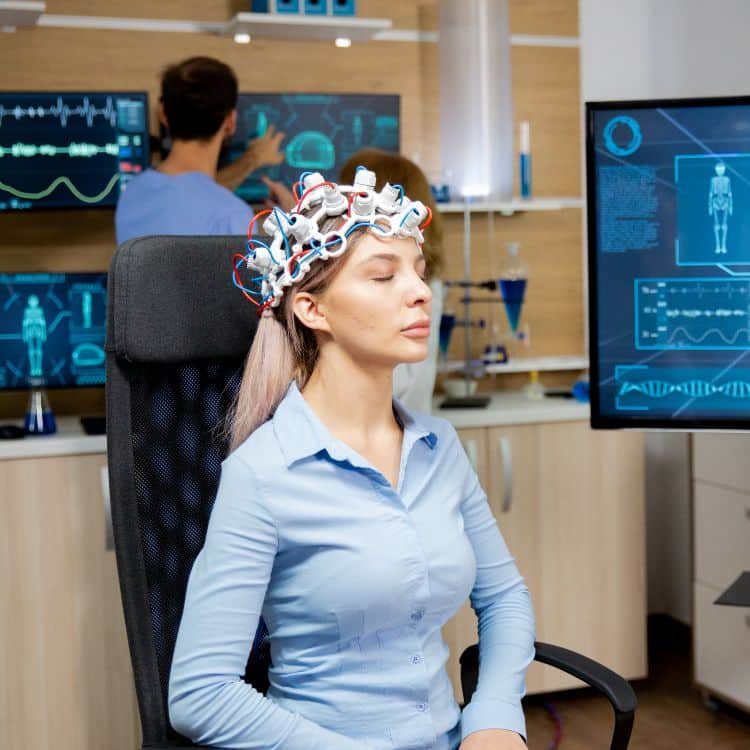qEEG Brain Mapping in San Diego
San Diego Dual Diagnosis Treatment Center
Call Now
The brain, an intricate web of interconnected neurons, is the epicenter of human cognition, emotions, and behaviors. Its health and functioning are paramount to our daily lives, influencing everything from our simplest decisions to our most profound memories. Given its complexity, it’s hardly surprising that the introduction of external substances, particularly narcotics and alcohol, can deeply alter its natural rhythms and structures. Chronic exposure to mood and mind-altering substances can lead to both short-term disruptions and long-term damages, affecting not just the individual’s mental health but also their physical well-being, relationships, and overall quality of life.
Modern medical advancements, like quantitative electroencephalography (qEEG) or brain mapping, offer unprecedented insights into these changes, allowing medical professionals to diagnose, treat, and even predict neurological and psychological issues stemming from substance use. As we gain a better understanding of the profound impacts of different drugs on the brain, it becomes evident that comprehensive care, integrating both medical interventions and conventional therapy, is imperative for successful recovery and holistic well-being.
At Healthy Life Recovery, we believe in utilizing advanced diagnostic tools to help our patients achieve their best mental and emotional health. One of these tools is QEEG Brain Mapping, a state-of-the-art method to understand the intricate patterns and functions of the brain.
What is qEEG?
QEEG stands for Quantitative Electroencephalogram. It’s a diagnostic tool that measures electrical activity in the form of brain wave patterns, often referred to as “brain mapping.” These brain waves are rhythmic impulses that occur when the countless neurons in the brain communicate. They can provide insights into your overall brain function, stress levels, emotional responses, and even potential symptoms such as anxiety, impulsivity, and cognitive rigidity.
At Healthy Life Recovery, we are dedicated to the specialized care of addiction and mental health. We understand the unique challenges faced by our patients and use QEEG among other tools to formulate personalized treatment plans. We use a CGX system that has a reputation for designing the most accurate data-rich dry EEG systems for researchers and practitioners.

The Benefits of qEEG
Quantitative Electroencephalography, commonly referred to as qEEG, represents a groundbreaking stride in neuroscience and mental health diagnostics. This state-of-the-art technology captures detailed electrical patterns of the brain, offering a nuanced, real-time visualization of its activity. By mapping out these intricate neural pathways, qEEG provides unparalleled insights that go beyond traditional diagnostic methods. The advantages of this technology span various facets of mental health care, from early detection to tailor-made treatment plans. Below, we delve into the myriad benefits of qEEG, underscoring its transformative potential in modern medicine:
- Personalized Treatment Plans: QEEG helps in understanding brain activities, allowing us to create treatments tailored for each individual.
- Identifying Issues: QEEG can detect cognitive and psychiatric problems that may be underlying or associated with addiction.
- Progress Tracking: Through QEEG, we can objectively monitor the effectiveness of treatments over time.
- Predicting Medication Response: QEEG can indicate how a patient might respond to specific medications, making treatments more precise and effective.
- Comprehensive Evaluation: Used alongside other methods, QEEG offers a complete view of brain function, helping in diagnosis and treatment.
Who Should Consider QEEG?
Quantitative Electroencephalography (qEEG) is an advanced diagnostic tool that provides a detailed look at the electrical activity in the brain. While this technology has broad applications, it holds particular significance for individuals with mental health disorders. By illuminating the unique neural patterns associated with each condition, qEEG can aid in more precise diagnoses and treatment plans. Here are some of the mental health disorders where qEEG can offer significant benefits:
Attention-Deficit Hyperactivity Disorder (ADHD)
In ADHD patients, qEEG can spotlight irregularities in brainwave patterns, especially in areas responsible for focus and impulse control, helping in distinguishing ADHD from other conditions with similar symptoms.
Anxiety Disorders
qEEG can identify areas of the brain that are hyperactive or underactive, often providing insights into the underlying neural mechanisms of anxiety, from generalized anxiety disorder to panic disorders.
Depression
For those struggling with depressive disorders, qEEG can reveal abnormal brainwave patterns that may correlate with the severity and type of depression. This can lead to more targeted therapeutic interventions.
Schizophrenia
This tool can help detect anomalies in brainwave activity linked to schizophrenia, providing valuable information about the disorder’s progression and potential interventions.
Bipolar Disorder
qEEG can offer insights into the cyclical nature of bipolar disorder by mapping the brain’s electrical patterns during manic and depressive episodes.
Post-Traumatic Stress Disorder (PTSD)
For those who have experienced trauma, qEEG can trace abnormalities in brain function that might be causing flashbacks, heightened arousal, or avoidance behaviors.
Obsessive-Compulsive Disorder (OCD)
With qEEG, clinicians can observe neural patterns associated with compulsions and obsessions, guiding more effective therapeutic strategies.
Autism Spectrum Disorders
qEEG can aid in understanding the brain function variations in individuals with autism, which can assist in tailoring interventions to the person’s specific needs.
Substance Use Disorder and Addiction
As addiction affects neural pathways, qEEG can provide insights into the brain’s response to various substances and can be a tool in monitoring recovery and potential relapses.
The above are just a few examples, and the applications of qEEG are vast. For anyone facing neurological or psychiatric conditions or for those seeking a deeper understanding of their brain’s function, qEEG offers an invaluable perspective.

qEEG Research Insights
QEEG’s value is further emphasized by extensive research backing its efficacy across various clinical scenarios:
- Depression: A hallmark of QEEG’s utility in mental health is its ability to identify a distinctive brain wave pattern linked with depression. This unique capability has empowered researchers to differentiate depression from other conditions. For instance, QEEG has been instrumental in distinguishing depression from ailments such as dementia, schizophrenia, and alcoholism.
- ADD/ADHD: Other clinical indications where QEEG has shown promise include distinguishing ADD/ADHD patterns and providing a deeper understanding of many mental health challenges. The insights derived from QEEG assessments have continuously paved the way for more informed and effective treatments.
qEEG in Addiction Treatment
The Brain’s Vulnerability to Addiction
While the brain is a powerful organ responsible for various essential functions, it’s also vulnerable to the impact of drugs and alcohol. Continuous exposure to mood and mind-altering substances, as seen in addiction, profoundly influences both brain activity and chemistry. Each intoxicant uniquely affects the brain, with lasting consequences if not appropriately addressed.
Much like an interconnected electrical grid, our brains comprise “hubs” that interlink various functions, from memory and decision-making to emotional processing. These vital hubs suffer during prolonged addiction, manifesting in symptoms like attention deficiency, memory loss, anxiety, depression, and other psychological challenges.
The Substance Influence on Brain Chemistry
Most narcotics, including alcohol, prompt the brain to release abnormal levels of dopamine, a neurotransmitter integral to the brain’s reward system (known as the Limbic System). Chronic users often exhibit disrupted neural pathways for dopamine and other crucial neurotransmitters. Recovery involves repairing these pathways.
Moreover, each drug uniquely impacts the brain:
Alcohol
Chronic alcohol abuse can negatively impact blood flow to the brain, especially affecting metabolism within the frontal lobes, which are responsible for functions like motor control, memory, problem-solving, judgment, language, and impulse regulation. Thankfully, with appropriate treatment and abstaining from alcohol, it’s possible for the frontal lobe to heal and regain its standard functionality.
Methamphetamine
Prolonged methamphetamine use damages the frontal lobe neurons, notably leading to significant dendrite loss—the extensions of nerve cells vital for transmitting electrochemical messages. This damage is indicative of methamphetamine-induced brain harm. Additionally, methamphetamine addiction correlates with diminished activity in the prefrontal cortex, particularly influencing decision-making processes.
Cocaine
The repercussions of unaddressed cocaine abuse can be severe, affecting critical areas of the brain. For instance, it impacts the amygdala, which is crucial for emotional learning. Anomalies in the amygdala’s functioning among cocaine addicts are tied to intense drug cravings. Furthermore, cocaine disturbs the anterior cingulate cortex’s operations, which is essential for emotion and memory processing. This disruption can persist even after cessation of drug use.
Ecstasy and MDMA
Regular MDMA consumption can inflict significant harm on the brain’s serotonin neurotransmitters due to chronic overstimulation. This damage can disrupt the brain’s capability to learn, manage sleep patterns, and process emotions. Given ecstasy’s suppression of basic physiological needs, like sleep and hydration, there are indirect consequences on the brain’s health and functionality.
Heroin and Opioids
Research confirms that most heroin or opiate users experience dysregulated neuron oscillations, affecting alpha, beta, delta, and theta brain waves. Encouragingly, quantitative electroencephalography studies indicate that brain wave patterns in recovering addicts can normalize within just three months. Nonetheless, without intervention, prolonged abuse of heroin and opiates can damage the brain’s white matter—comprising axon bundles that interconnect various brain regions.
Embracing Brain Mapping at Healthy Life Recovery
Recognizing addiction’s complexity, we understand that it interweaves genetic, environmental, and learned behavioral factors. Unlike diseases pinned to a single gene mutation, addiction’s genetic influence is multilayered, intertwining the expressions of hundreds of genes. Substances like alcohol and narcotics can instigate persistent neuroadaptive changes by overstimulating gene regulatory mechanisms, laying the foundation for addiction.
Continuous drug consumption leaves its mark on our genetic composition, reshaping how brain cells communicate and interact. Those with substance use disorders exhibit altered cognitive thinking and reward systems, deviating from typical patterns.
At Healthy Life Recovery, we champion a nuanced perspective: addiction is a disease that demands precision and scientific intervention. By leveraging modern diagnostic tools like EEG and brain mapping, we’re committed to pinpointing and addressing the root of addiction, ensuring holistic healing.
Is QEEG Safe?
QEEG is non-invasive and painless. The electrodes, which are placed on the scalp, merely “read” the brain’s signals without altering any activity. It’s a transparent method to determine the areas where brain wave activity is underactive, overactive, or just right.
Undergoing a QEEG test at Healthy Life Recovery is a simple and stress-free process. A cap, resembling a bathing cap but with electrodes, is placed on your head. These electrodes capture your brain’s electrical activity, which is then interpreted by our state-of-the-art software. The entire process, from recording to interpretation, takes about 30 minutes. The patterns and maps derived from the QEEG will be used to understand your brain’s function and devise a treatment plan optimized for you.

Get Started with QEEG at Healthy Life
At Healthy Life Recovery, our mission is to provide holistic, data-driven approaches to addiction and mental health treatment. QEEG Brain Mapping represents one of our most advanced tools, offering a detailed insight into brain function. It allows for a nuanced understanding of individual challenges and strengths, ensuring that every patient receives care that is tailored to their unique needs.
Our center is more than just a treatment facility; it’s a community. From support groups to dedicated clinicians, we aim to create an environment where patients feel understood and supported every step of the way.
When you choose QEEG Brain Mapping at Healthy Life Recovery, you’re not just getting a diagnostic tool; you’re gaining access to a community that’s dedicated to helping you achieve mental and emotional wellness. Contact us today!

Medically Reviewed By:
Dr. Sanjai Thankachen
Dr. Sanjai Thankachen graduated from Adichunchanagiri Institute of Medicine in 2000. He completed his residency in psychiatry in 2008 at Creedmoor Psychiatric Center in New York. Dr. Thankachen is currently working with Pacific Neuropsychiatric Specialists in an outpatient practice, as well as working at multiple in-patient psychiatric and medical units bringing his patients the most advanced healthcare treatment in psychiatry. Dr. Thankachen sees patients with an array of disorders, including depression, bipolar illness, schizophrenia, anxiety, and dementia-related problems.

Edited for Clinical Accuracy By:
Sean Leonard, Psychiatric Nurse Practitioner
Sean Leonard is a board-certified psychiatric nurse practitioner. He received his master’s degree in adult geriatric primary care nurse practitioner from Walden University and a second postmaster specialty in psychiatry mental health nurse practitioner from Rocky Mountain University. Sean has experience working in various diverse settings, including an outpatient clinic, inpatient detox and rehab, psychiatric emergency, and dual diagnosis programs. His specialty areas include substance abuse, depression, anxiety, mood disorders, PTSD, ADHD, and OCD.
